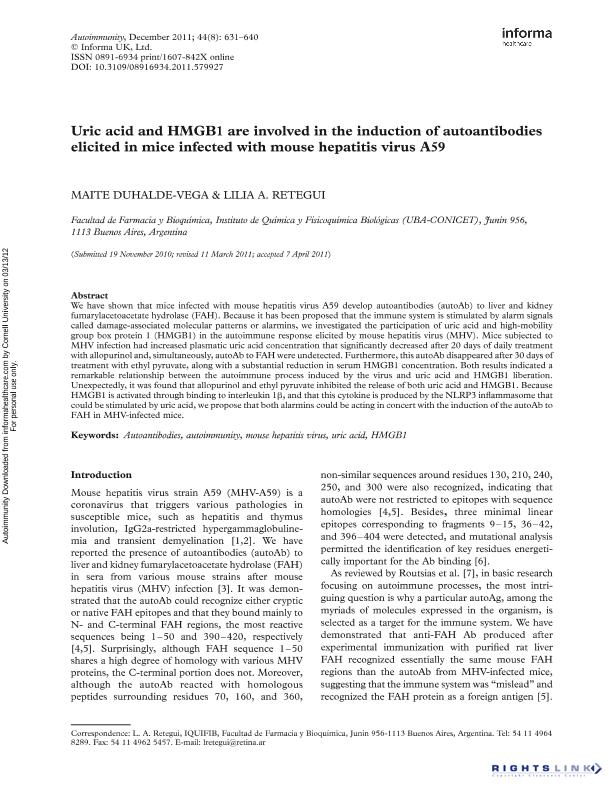Mostrar el registro sencillo del ítem
dc.contributor.author
Duhalde Vega, Maite

dc.contributor.author
Retegui, Lilia Alicia

dc.date.available
2017-06-14T20:30:49Z
dc.date.issued
2011-12
dc.identifier.citation
Duhalde Vega, Maite; Retegui, Lilia Alicia; Uric acid and HMGB1 are involved in the induction of autoantibodies elicited in mice infected with mouse hepatitis virus A59; Taylor & Francis; Autoimmunity; 44; 8; 12-2011; 631-644
dc.identifier.issn
0891-6934
dc.identifier.uri
http://hdl.handle.net/11336/18206
dc.description.abstract
We have shown that mice infected with mouse hepatitis virus A59 develop autoantibodies (autoAb) to liver and kidney fumarylacetoacetate hydrolase (FAH). Because it has been proposed that the immune system is stimulated by alarm signals called damage-associated molecular patterns or alarmins, we investigated the participation of uric acid and high-mobility group box protein 1 (HMGB1) in the autoimmune response elicited by mouse hepatitis virus (MHV). Mice subjected to MHV infection had increased plasmatic uric acid concentration that significantly decreased after 20 days of daily treatment with allopurinol and, simultaneously, autoAb to FAH were undetected. Furthermore, this autoAb disappeared after 30 days of treatment with ethyl pyruvate, along with a substantial reduction in serum HMGB1 concentration. Both results indicated a remarkable relationship between the autoimmune process induced by the virus and uric acid and HMGB1 liberation. Unexpectedly, it was found that allopurinol and ethyl pyruvate inhibited the release of both uric acid and HMGB1. Because HMGB1 is activated through binding to interleukin 1β, and that this cytokine is produced by the NLRP3 inflammasome that could be stimulated by uric acid, we propose that both alarmins could be acting in concert with the induction of the autoAb to FAH in MHV-infected mice.
dc.format
application/pdf
dc.language.iso
eng
dc.publisher
Taylor & Francis

dc.rights
info:eu-repo/semantics/openAccess
dc.rights.uri
https://creativecommons.org/licenses/by-nc-sa/2.5/ar/
dc.subject
Autoantibodies
dc.subject
Autoimmunity
dc.subject
Mouse Hepatitis Virus
dc.subject
Uric Acid
dc.subject
Hmgb1
dc.subject.classification
Bioquímica y Biología Molecular

dc.subject.classification
Ciencias Biológicas

dc.subject.classification
CIENCIAS NATURALES Y EXACTAS

dc.title
Uric acid and HMGB1 are involved in the induction of autoantibodies elicited in mice infected with mouse hepatitis virus A59
dc.type
info:eu-repo/semantics/article
dc.type
info:ar-repo/semantics/artículo
dc.type
info:eu-repo/semantics/publishedVersion
dc.date.updated
2017-06-14T14:34:54Z
dc.journal.volume
44
dc.journal.number
8
dc.journal.pagination
631-644
dc.journal.pais
Reino Unido

dc.journal.ciudad
Londres
dc.description.fil
Fil: Duhalde Vega, Maite. Consejo Nacional de Investigaciones Científicas y Técnicas. Oficina de Coordinación Administrativa Houssay. Instituto de Química y Físico-Química Biológicas "Prof. Alejandro C. Paladini". Universidad de Buenos Aires. Facultad de Farmacia y Bioquímica. Instituto de Química y Físico-Química Biológicas; Argentina
dc.description.fil
Fil: Retegui, Lilia Alicia. Consejo Nacional de Investigaciones Científicas y Técnicas. Oficina de Coordinación Administrativa Houssay. Instituto de Química y Físico-Química Biológicas "Prof. Alejandro C. Paladini". Universidad de Buenos Aires. Facultad de Farmacia y Bioquímica. Instituto de Química y Físico-Química Biológicas; Argentina
dc.journal.title
Autoimmunity

dc.relation.alternativeid
info:eu-repo/semantics/altIdentifier/url/http://www.tandfonline.com/doi/abs/10.3109/08916934.2011.579927?journalCode=iaut20
dc.relation.alternativeid
info:eu-repo/semantics/altIdentifier/doi/http://dx.doi.org/10.3109/08916934.2011.579927
Archivos asociados
